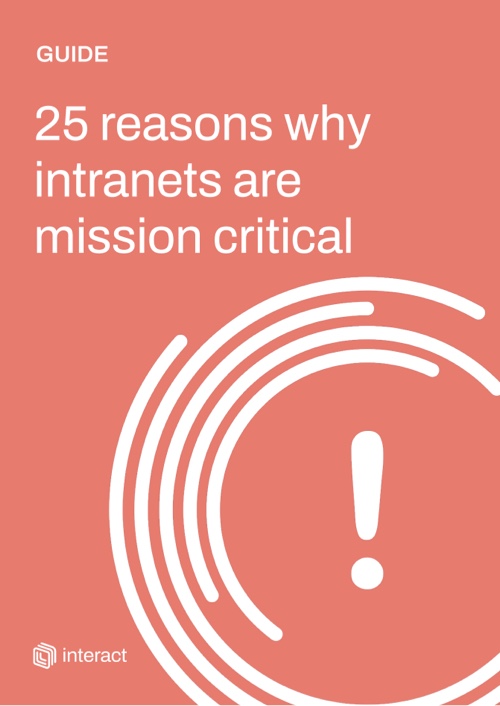Employee lifecycle management: 6 tips on things you should be doing

Employee lifecycle management (ELM) is something that every HR department should prioritize. This is the process that focuses on the nurturing and developing of a company’s most critical asset: its people.
What is Employee Lifecycle Management?
The different stages an employee goes through during their time at an organization. HR’s role during ELM is vital and begins even before the employee has been hired.
In HR, it’s generally accepted that there are six stages in ELM: Outreach, recruitment, onboarding, development and training, performance, and offboarding. The process encompasses the way the organization presents itself, the way it interacts with candidates, how it welcomes people into the business and manages their personal and professional development within the company.
23 ways your workplace can use a mission-critical intranet to achieve its objectives
Within ELM, a business can explore all the ways they can positively impact their employees’ time at the organization. Providing an enjoyable experience for your workforce has many great benefits, which include higher staff retention, greater employee satisfaction, and higher productivity levels.
Exploring each step of the process, we will highlight what you should be doing as a business to improve the way you manage your employees’ time at the organization.
#1 Outreach

An employee’s lifecycle begins when an individual first encounters an open position. There is now a wide range of outreach channels, including social media and online job sites. While the organization has a limited impact on the individual, certain things can be done to influence the job seeker: a full, description of the role, details on the workplace, and the perks available.
Candidates are also using social media more frequently to search and apply for jobs with almost 60% of them using it to research companies before applying to them.
Tip: The first port-of-call for people answering your job ad is your website. First impressions count, which is why it’s so important to make sure your company’s message and image are on point.
Follow the journey of someone responding to outreach. Make sure that within the first few seconds, your website can convey what your organization does, its purpose, and its value proposition. This adds extra weight to the advertised job role and increases engagement.
#2 Recruitment

Growing your business starts with having the right people. In order to succeed, the HR department should have a strategic recruiting process in place. To make the right impression on the candidate, attention needs to be given to the details straightaway. This includes reviewing the benefits package and making sure you are offering as much as possible to attract the best candidates. You should also make sure that formulate your interview process. Work out a complete plan for your interviewing process. This could include how you work out your final group of candidates to interview, how many interviews you hold, and any additional tests you incorporate into the process (verbal reasoning, Myers-Brigg test etc).
Talent shortage is a real issue in the current market. Almost three quarters (72.8%) of employers are having a difficult time finding skilled candidates, and 45% of employers are concerned about finding employees with the necessary talents.
Manpower
Tip: To get the right person in the role, you need to ensure you have the correct job descriptions. Up-to-date and detailed job adverts will capture the right level of skill and competency that you need. Update your roles and responsibilities – ensure that the roles and responsibilities that you’ve given to each position are regularly checked and up to date.
#3 Onboarding

Most employees will have decided within the first 90 days whether they want to remain at the company. Considering that the cost of losing an employee in the first year could be up to three times the person’s salary, then it’s clear that onboarding is a crucial stage. This part of the lifecycle should include a number of things, including training, establishing new relationships, and developing a niche and, above all, focus on making the individual feel supported. Those companies who have developed their onboarding process report increased engagement levels decreased employee churn, and a host of other key benefits.
Organizations with a strong onboarding process improve new hire retention by 82 percent and productivity by over 70 percent.
Glassdoor
Tip: While there are plenty of areas to focus on during the onboarding process, there is one major thing to bear in mind. Many organizations treat their onboarding process as a necessary but brief stage to tick off the list. However, the onboarding process shouldn’t be restricted to the first week or even the first month of an employee’s time at the organization. If your focus is keeping the best talent in-house for as long as possible, you need to think more long-term. The most successful onboarding processes extend beyond the first few weeks and go on throughout the year. This ensures all new hires are fully supported as they get to grips with their roles.
23 ways your workplace can use a mission-critical intranet to achieve its objectives
#4 Development and Training

Traditionally seen as a low point in the new starter experience, there have been plenty of improvements to remedy training and development’s poor reputation. The digital workplace is the perfect hosting platform to hold a wide array of educational tools.
Training and development an essential component of the employee lifecycle. It can progress their abilities and evolve new skills in the employee – which has wider benefits for the business. Training is also particularly pertinent with the advancement of technology. It is now imperative that all employees, of all ages, keep up to date with the latest digital tools available to them. Investing in effective training can increase morale and job satisfaction as well as improve employee performance. Thus, the employee is happier in their role, and offers more value to the business.
The total loss to a business from ineffective training is $13.5m per year per 1,000 employees.
Shift ELearning
Tip: The digital workplace has gone someway to apply new developments in coaching. Gamification and e-learning, for example, is a popular method that has proven to be successful for both starters and long-term employees. This kind of interactive learning boosts employee engagement and the ability to take on large or complex batches of information more easily. By making interactive learning experiences, the traditional PowerPoint instruction is cast aside, and the learner drives their own training forward.
#5 Performance

As an organization progresses with its training and developing, performance management should go hand-in-hand. Implementing performance appraisals and evaluations gives employees an idea of their progress and standing in the business. This not only helps to retain the worker but also ensures continued development. Evaluating and recognizing the employee improves job satisfaction and engagement.
It’s with this monitoring that helps identify employees for promotion and any weak spots in training. But, depending on the size of the organization, keeping a check on the performance of a workforce requires software and tools to support HR and management teams. These can include mentoring programs, succession-planning, and e-learning developing programs. And recognizing good performance is key. Employment recognition is so impactful to a positive culture, but so often overlooked. There are many ways to celebrate a great performance, so it’s recommended that the protocol is in place for those occasions when it’s time to say ‘well done.’
58% of employees say employee recognition is how leaders could do more to improve employee engagement.
Psychometrics, A Study of Employee Engagement in the Canadian Workplace 2010
Tip: Employee recognition has a huge influence on company culture and behaviors of staff. For long term success, align your employee recognition schemes with your company values. This approach will connect the attitude and performances of staff to the integral belief system of the organization. Interact’s employee recognition scheme is hosted on our intranet system by way of the giving and receiving of ‘donuts.’ When staff thank each other, they can gift donuts to the recipient, and this is broadcast on a scrolling feed on the intranet homepage. Each thank you is footnoted with one of our business’s core values by way of a hashtag, so #putpeoplefirst, #wefixthings #takepride and #enjoyworkingdifferently.
#6 Offboarding

For every employee, the lifecycle has to end at some point. It could be retirement, further education, a new job, or for personal reasons. So many businesses treat departures very negatively, seeing it as a personal and professional slight that someone has moved on. And even those organizations who behave magnanimously, miss out on a valuable opportunity. A departure can be an incredibly revealing time that management should make as positive as their onboarding process. Although some situations might be unworkable, making sure the majority of your employee leave in the best possible way can bring significant ROI to the business. Happy ex-employees act like brand ambassadors, provide job referrals, and can even return to the fold in the future. Maintaining good relationships with individuals who have left also carries none of the risks that disgruntled ex-employees have.
Nearly 40% of workers indicate they’d consider going back to a company where they’d previously worked.
Workplace Trends
Tip: Make sure all parties concerned have a checklist for offboarding. This means that IT should change access to sensitive data, HR carries out all necessary paperwork, and line managers handle their leaving and the impact on the team responsibility. But more than anything, keep up communication – inform your leaver about what the protocol is. Let them know that there will be elements of their departure, which might feel slightly cold and clinical, like handing back fobs and phones. Make sure you check in on them during the last few weeks with chats and catch-ups. And most importantly, speak with them and get their feedback on their time at the organization. This could provide valuable lessons for the business and allow you to identify any weak spots and issues.
To create the best employee experience for your people, attention needs to be given to your employee lifecycle management. Not only do you have to make decisions on the right tools and processes need to support an employee’s journey with their company, but you also need to develop a solid structure for your ELM processes.
While this structure is open to refinement, it is something that will provide a consistent series of steps for your employees. With the right software, it will also allow your management and HR department to analyze data — identifying any issues or vulnerabilities — which will lead to improvements across the organization.

